For a couple of weeks now we’ve had some animated discussions on introduced plants (invasive or otherwise) and native species. One of our commenters wondered whether many introduced invasives (those that take advantage of disturbed conditions) would eventually become controlled through succession (which in our part of the country means land dominated by trees and shrubs). And yes, if native species can get a foothold in an infested site, invasive species become less dominant.
To illustrate, I’ll take you on a virtual trip in our neighborhood’s pocket wetland. In 2000, this tiny triangle was dominated by reed canary grass (RCG) and had been for years; a few blackberries, cattails and nightshade were the only other obvious species.
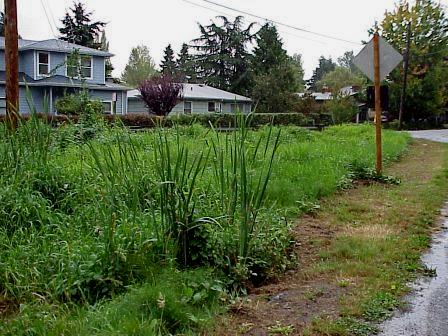
The triangle in 2000 looking west….
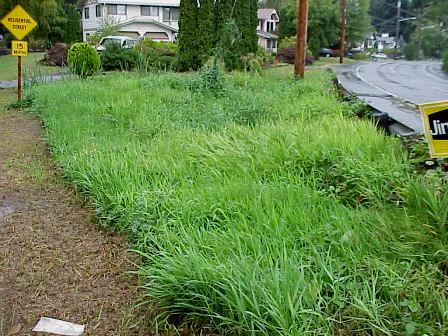
…and east
The city would mow the grass every so often, along with trees that my neighbors had futilely planted. We decided to take this on as a class project (this was when I was on faculty at University of Washington).
When we began to clear out the vegetation, we were stunned to realize that there was a creek running through what seemed to be a flat chunk of land.
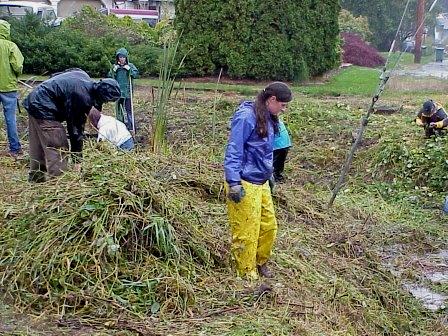
We cleared out as much RCG as possible and mulched the entire area (note that many restoration ecologists recommend taking out soil to a depth of 18″ to remove all the stolons). We knew the grass would come back, but our task was to jump start the system and get some native plants started. We installed a single Douglas fir and a single western hemlock (these are large trees at maturity), along with live stakes of native willow, dogwood and snowberry. We planted a few Oregon grape and other smaller shrubs.
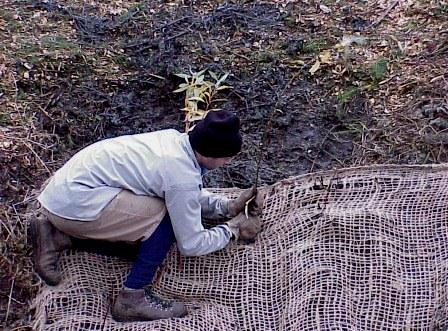
Live stakes planted through coir cloth (used to temporarily hold mulch in place).

The 2001 installation, looking east. The Douglas fir is next to the group, and the hemlock is in the foreground.
Over the next few years the RCG came back with a vengeance. We held occasional work parties to keep the grass at bay, but after I took a new position at WSU I no longer had the student work force that allowed me to keep this area partially controlled. It became a one-family project, and not one that we had a lot of time for.

2003 work party dredging out the creek. You can’t see the natives we installed in 2001, but they’re in there.
Fortunately, nature took over for us. The willows we had planted grew like weeds, creating a canopy under which RCG doesn’t do so well.

The Douglas fir and hemlock got established, as did the snowberry and one Oregon grape. For the most part, we were able to weed whack the RCG on the very steep slopes and keep the flatter areas covered with wood chips.
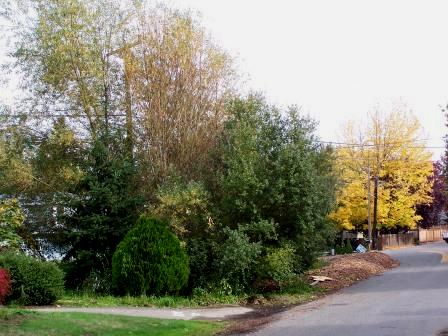
Restoration site in 2009, looking west…
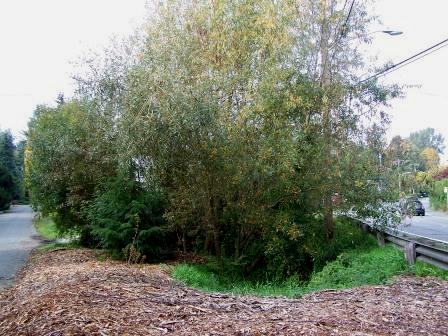
…and east.
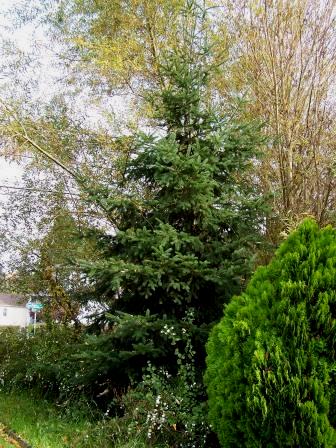
Eight year old Douglas fir…
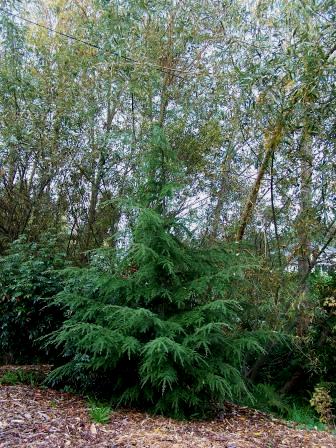
…western hemlock…
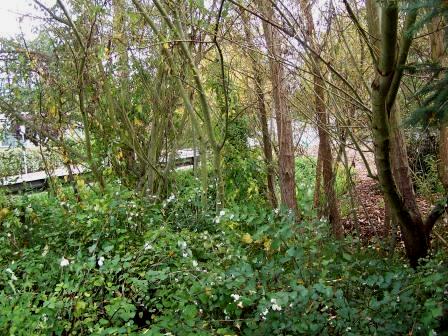
…and snowberry.
Will the RCG ever be completely gone? I doubt it; the seedbank must be incredible, and there are many other RCG colonies upstream. But it no longer dominates the landscape: it’s become assimilated. And that’s really the point: nature adapts.
[As an aside: I really don’t like the term “restoration.” We’re not taking landscapes back to some pristine original as the term implies. “Assisted succession” more accurately and realistically describes this process.]
Wow – what an incredibly useful post! I’ve had plenty of discussions about the idea of ‘jump-starting succession’, but your posts show it actually working! Thanks for a piece I’ll refer to for evidence of an over-time success.
Fantastic. This seems like a great way to deal with invasives that are as difficult to eradicate as RCG.
It could also be called, “creating a novel ecosystem.”
Very nice post on *cough – cough* restoration. I guess when I hear or use the word Restoration, I include the use of ‘Habitat’, since I picture a restored situation where birds, animals, reptiles, amphibians etc are made welcome and even themselves shape and mould the habitat. There is no way to completely eradicate anything. Watch the word/term invasive become the new Biodiversity -LOL
Come on folks get with the discussion. I thought this post Linda would spark more inquiry. There is another word that came back to me as I was meditating on your post yesterday. The word is Reclamation. When I was going to school in the early 1960s, I remember films and textbooks demonizing wild areas of nature as useless to human endeavors and how it was human responsibility to reclaim the land for productive use. As if the land was serving no productive purpose in the first place. The one outstanding example was the Brazilian city called Brazilia the capitol of Brazil. The explanation is of how worthless rainforest swamp was being turned into productive uses for human beings. I remember the same excuse used in Florida’s draining of useless swamp lands for productive agricultural usage. My how times and viewpoints have changed
With no knowledge or plan for what I was doing, I planted 40 or 50 tree saplings and shrubs in among the rampant weeds that had blanketed a hillside our builder had scraped away during construction. I had no hope of those saplings overtopping the 8 foot tall goldenrod, pokeweed, multiflora rose etc. But it is happening. Six years later a mini forest is starting to shade out the rampant weeds, and it is starting to look like your assisted succession plot. I love knowing that my quixotic tree planting project is actually an establish succession plan for controlling the original (invasive) colonizers, and it is really working.
As I am the commentator who posed the initial question, want to thank Dr. Scott for following up with this post.
My initial point being: given the fact(s) of succession, and the ephemeral role played by these early, ‘invasive’ colonizers, isn’t the current hysteria (my take…) around ‘invasive plants’ and their supposed harm to local nature a tad overblown, more a consequence of an overly temporal perspective?
I would imagine that even without human intervention, given enough time various opportunities would emerge for the next stage of succession to proceed (ie. soil changes wrought by the colonizer, increasing shade–as mentioned in the comments, etc.)
Don’t want to push a body analogy too far, as the landscape is obviously and profoundly different, but given their tendency to quickly cover disturbed sites, aren’t a lot of ‘invasives’ invasive in a manner akin to platelets rapidly colonizing and seal an open wound? Can they be viewed as temporary (in biologic, perhaps geologic time) healers of ruptured spaces?
In the town where I grew up, we played on a desert of dredge tailings from the boating channel: I watched it go from sand to blackberry and broom, to seedling alders and cottonwoods, which shaded out the blacberry and broom. Now, thirty years later, it’s mostly an alder forest, with no broom in sight, and greatly diminished blackberry patches…all this with no human intervention.
I find it remarkable that such stories aren’t legion in this ‘debate;, and often wonder why?
Oops…Dr. Chalker-Scott, not Dr. Scott. Apologies.
@ digger, no problem. As my grandfather used to say, “call me anything you like, just don’t call me late for dinner.”
Laurie, if you have before and after photos, it would be fun to post them. Let me know.
Kevin, thanks for the reminder of how our environmental values have changed as well as for the kick in the pants. And it would also be fun to discuss the issue of impatience (as in @digger’s post) – whether it’s the homeowner wanting an instant landscape or a restoration ecologist wanting a quick fix to a degraded site.
@skr, you’re right – this is the “new biodiversity” as Kevin points out. It’s sure better than the alternative weedy monoculture.
And Deb, thanks for the thumbs up! Use this as often as you can with my blessings.
I am going to throw in with Kevin, above. An ‘island’ parcel such as this is definitely a ‘reclamation,’ or perhaps even ‘renovation;’ I don’t think that you can ‘restore’ something that is so far removed from its original state.
When my home was built, only 5 1/2 feet was cleared beyond the building envelope. Among the vegetation that was cleared was a small stand of vine maple, some salal and sword fern, bracken and sundry weeds, two red alder (whose forest job it is to grow quickly, fix nitrogen, and then die and rot) and ONE Doug Fir of approximately 16″ caliper. Presumably, the Mitigation Planner was there counting up to arrive at the total of 289 Native plants necessary for “mitigation.” But the plants themselves had to go into the area surrounding the home, not back into the construction zone.
The area surroun
ding the home was a clearing and had likely been so since the land was clear-cut in the 1930’s and 40’s. The contributing factors to this condition were: the inexorable alteration of the land by removal of climax timber and the resulting runoff–which washes all friable soil into the adjacent wetland–and Mountain Beavers. This animal has a very human-like tendency to establish and maintain its territory by making it inhospitable to other forest creatures. Nobody likes bracken and weeds like Mountain Beavers do.
By forcing me to eradicate “invasives” in the clearing, and to plant and maintain it with native plants only, my city government has caused me to create a Mountain Beaver Preserve, wherein there is enough vegetative browse to support more Mountain Beavers than would be customarily found in a range. More Mountain Beavers feed on my fresh browse. I plant new plants, more get eaten; more Mountain Beavers occupy the range. It is enormously self-defeating, and monstrously expensive.
A friend of mine who used to supervise forest restoration projects for the State of Washington told me, anyone should know “you can’t Mitigate a clearing.” Two years and nearly $30,000 in compulsory native plantings and associated costs, and I am here to tell you that is true.
I am still alarmed by the disconnect between the pro-and con- ciscussion of this and what it means in the real world, to real people.
As I previously pointed out, the general scarcity of NW Native plants and their elevated expense does not bode well for the landscape profession or plain old people. If the single table/grid of natives that is available at Swanson’s, Molbak’s or Gray Barn are not enough to supply my 8,000 square foot clearing, I am not sure where everybody else’s native plants are going to come from.
When I began chronicling life with a property restricted by law to 100% NW native plants on my blog, A Thistle in my Sensitive Area, it was in part because I thought I had a nearly unique situation. I still think this (and for anyone who might think ‘if you don’t like the situation, why did you buy it?’ I can tell you that the restrictions in place when I purchased were not as restrictive as those when we reached the completion of construction–some of the restrictions were made up on the spot in collaboration between the City biologist and the Mitigation Planner, whose services I was compelled to pay for), for I have yet to ever say ‘this is what happened when I was compelled by law to plant natives only.’ If anyone wants to learn what policies such as this mean in a real-world application, I invite you to visit, and if anyone wants to know how public policy and ordinance is developed, read the ‘green, or Green?’ series.
And a sidebar on the FNPS–when my own situation became clearer to me, I realized I needed to become more educated on native plants and native plants issues, and quickly. The FNPS responded to my Twitter follow request by telling me that ‘the interests of the FNPS were limited to Florida only, and they did not recommend I follow.’ Glad to see they’ve expanded their scope to Washington State land-use regulations. Hisss!
Dr. Chalker-Scott,
My climate and local plants here in the hot & humid southeast are radically different than yours, so I won’t ask for specific advice, but I have a similar area overrun by invasives and have been unable to get anything else established although I believe the undesirable plants would be controlled if I can perform a similar “jumpstart.” Are there any resources, especially case studies, that you can recommend as reading material to help me come up with a cohesive plan?
Nicole, you can find some information relevant to this on my web site (http://www.puyallup.wsu.edu/~Linda%20Chalker-Scott/Fact%20sheets.html), both under the fact sheets and the Herons Glen case study.
Thank you, I’ll take a look!